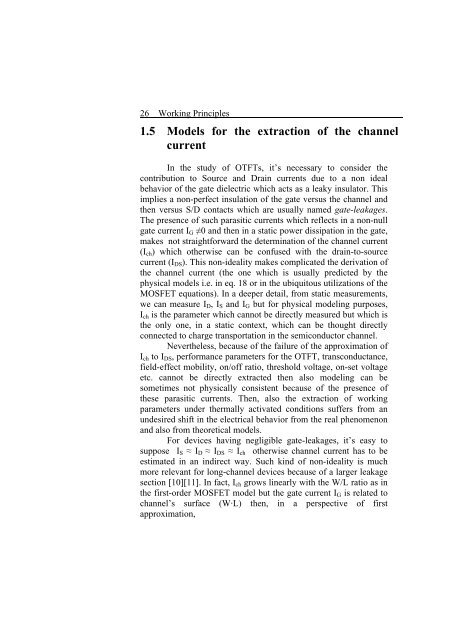tesi R. Miscioscia.pdf - EleA@UniSA
tesi R. Miscioscia.pdf - EleA@UniSA
tesi R. Miscioscia.pdf - EleA@UniSA
Create successful ePaper yourself
Turn your PDF publications into a flip-book with our unique Google optimized e-Paper software.
26 Working Principles<br />
1.5 Models for the extraction of the channel<br />
current<br />
In the study of OTFTs, it’s necessary to consider the<br />
contribution to Source and Drain currents due to a non ideal<br />
behavior of the gate dielectric which acts as a leaky insulator. This<br />
implies a non-perfect insulation of the gate versus the channel and<br />
then versus S/D contacts which are usually named gate-leakages.<br />
The presence of such parasitic currents which reflects in a non-null<br />
gate current IG ≠0 and then in a static power dissipation in the gate,<br />
makes not straightforward the determination of the channel current<br />
(Ich) which otherwise can be confused with the drain-to-source<br />
current (IDS). This non-ideality makes complicated the derivation of<br />
the channel current (the one which is usually predicted by the<br />
physical models i.e. in eq. 18 or in the ubiquitous utilizations of the<br />
MOSFET equations). In a deeper detail, from static measurements,<br />
we can measure ID, IS and IG but for physical modeling purposes,<br />
Ich is the parameter which cannot be directly measured but which is<br />
the only one, in a static context, which can be thought directly<br />
connected to charge transportation in the semiconductor channel.<br />
Nevertheless, because of the failure of the approximation of<br />
Ich to IDS, performance parameters for the OTFT, transconductance,<br />
field-effect mobility, on/off ratio, threshold voltage, on-set voltage<br />
etc. cannot be directly extracted then also modeling can be<br />
sometimes not physically consistent because of the presence of<br />
these parasitic currents. Then, also the extraction of working<br />
parameters under thermally activated conditions suffers from an<br />
undesired shift in the electrical behavior from the real phenomenon<br />
and also from theoretical models.<br />
For devices having negligible gate-leakages, it’s easy to<br />
suppose IS ≈ ID ≈ IDS ≈ Ich otherwise channel current has to be<br />
estimated in an indirect way. Such kind of non-ideality is much<br />
more relevant for long-channel devices because of a larger leakage<br />
section [10][11]. In fact, Ich grows linearly with the W/L ratio as in<br />
the first-order MOSFET model but the gate current IG is related to<br />
channel’s surface (W·L) then, in a perspective of first<br />
approximation,
















